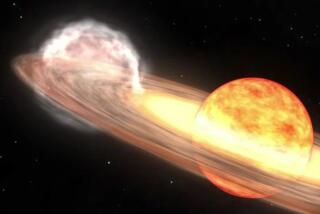Shuttle’s Ultraviolet Telescopes Zero In on Newly Exploded Star
- Share via
KENNEDY SPACE CENTER, Fla. — Endeavour’s astronauts aimed powerful ultraviolet telescopes Monday at a newly exploded star that is thousands of times brighter than it was before it burst.
Nova Aquilae erupted in a thermonuclear explosion a month ago. The white dwarf star had been tugging material from its larger companion star and built up a layer of hot gas that eventually blew up and was hurtled into space.
Scientists believe a new buildup of gas will start soon and that another outburst will occur thousands of years from now.
“Even though you just see a pinpoint of light, we can begin to interpret it in terms of drawing a three-dimensional picture of this event,” said Arthur Code, an astronomer at the University of Wisconsin at Madison who is in charge of one shuttle telescope.
Nova Aquilae is in the constellation Aquila, or Eagle, and is several thousand light years away.
Another nova erupted in late January and yet another just a little more than a week ago.
Both of these also will be viewed by the three ultraviolet telescopes aboard Endeavour so astronomers can learn more about the life cycle of stars.
Astronomers have logged more than 100 observations since the 15 1/2-day mission began Thursday. They have about 600 targets from which to choose, including stars, galaxies, quasars, moons and cosmic dust clouds.
Ground controllers were swamped trying to keep up with more than 500,000 requests for mission information pouring into the “Welcome to Astro-2” program via the Internet. This is NASA’s first on-line shuttle flight; virtually all aspects of the mission are available on the World Wide Web.
More to Read
Sign up for Essential California
The most important California stories and recommendations in your inbox every morning.
You may occasionally receive promotional content from the Los Angeles Times.













